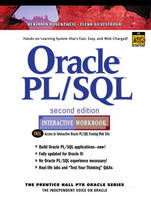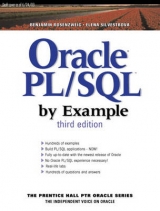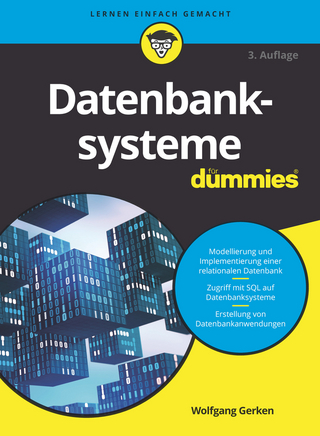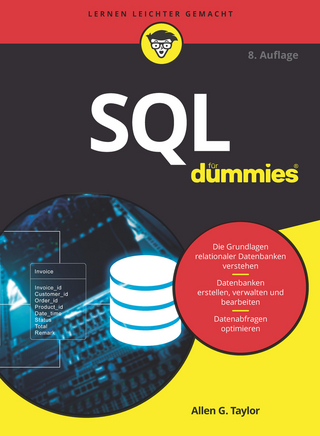
Oracle PL/SQL Interactive Workbook
Prentice Hall (Verlag)
978-0-13-047320-2 (ISBN)
- Titel erscheint in neuer Auflage
- Artikel merken
Learn PL/SQL hands-on, through practical exercises, self-review questions and real-world answers. This book teaches all the Oracle PL/SQL skills you need, through hands-on, real-world labs, exercises, projects, and our great Web-based training site! Coverage includes every key Oracle PL/SQL concept, including: the basics of structured programming; PL/SQL structure and syntax; iterative control; scoping and anchored datatypes; SQL within PL/SQL; for update cursors and subprograms; stored code, triggers, security, tables, even advanced-level package and parameter passing techniques. A free Web-based training module includes a Virtual Study Lounge where readers can interact with the author. As Oracle's premier tool for building store procedures, PL/SQL uniquely supplements the standard relational database language, SQL, with the features needed to build real-world applications. Oracle Developers typically learn SQL before venturing in to Oracle's PL/SQL. SQL is the foundation Language on which PL/SQL is build.
BENJAMIN ROSENZWEIG is an Integration Specialist at IQ Financial Systems. Prior to that he was a principal consultant for more than 3 years at Oracle Corporation in the Custom Development Department. His computer experience ranges from creating an electronic Tibetan-English Dictionary in Kathmandu, Nepal, to supporting presentations centers at Goldman Sachs and managing a trading system at TIAA-CREF. His previous Prentice Hall PTR publications include Oracle PL/SQL: The Complete Video Course and Oracle Forms Developer: The Complete Video Course. ELENA SILVESTROVA, a senior software engineer for a prominent New York brokerage firm and securities dealer, has taught relational database programming in Columbia University's CTA program during the past four years. She studied analysis and design at Columbia University and applied mathematics at Baku State University in Azerbaijan.
Acknowledgments.
About the Authors.
Introduction.
1. Programming Concepts.
LAB 1.1 The Nature of a Computer Program and Programming Languages. LAB 1.2 Good Programming Practices. Chapter 1 Test Your Thinking.
2. PL/SQL Concepts.
LAB 2.1 PL/SQL in Client-Server Architecture. LAB 2.2 PL/SQL in SQL*Plus. Chapter 2 Test Your Thinking.
3. General Programming Language Fundamentals.
LAB 3.1 PL/SQL Programming Fundamentals. Nested Blocks, and Labels. Chapter 3 Test Your Thinking.
4. SQL in PL/SQL.
LAB 4.1 Making Use of DML in PL/SQL. LAB 4.2 Making Use of SAVEPOINT. Chapter 4 Test Your Thinking.
5. Conditional Control: IF Statements.
LAB 5.1 IF Statements. LAB 5.2 ELSIF Statements. LAB 5.3 Nested IF Statements. Chapter 5 Test Your Thinking.
6. Conditional Control: Case Statements.
LAB 6.1 CASE Statements. LAB 6.2 CASE Expressions. LAB 6.3 NULLIF and COALESCE Functions. Chapter 6 Test Your Thinking.
7. Error Handling and Built-In Exceptions.
LAB 7.1 Handling Errors. LAB 7.2 Built-In Exceptions. Chapter 7 Test Your Thinking.
8. Iterative Control.
LAB 8.1 Simple Loops. LAB 8.2 WHILE Loops. LAB 8.3 Numeric FOR Loops. LAB 8.4 Nested Loops. Chapter 8 Test Your Thinking.
9. Introduction to Cursors.
LAB 9.1 Cursor Manipulation. LAB 9.2 Using Cursor FOR Loops and Nesting Cursors. Chapter 9 Test Your Thinking.
10. Exceptions.
LAB 10.1 Exception Scope. LAB 10.2 User-Defined Exceptions. LAB 10.3 Exception Propagation. Chapter 10 Test Your Thinking.
11. Exceptions: Advanced Concepts.
LAB 11.1 RAISE_APPLICATION_ERROR. LAB 11.2 EXCEPTION_INIT Pragma. LAB 11.3 SQLCODE and SQLERRM. Chapter 11 Test Your Thinking.
12. Procedures.
LAB 12.1 Creating Procedures. LAB 12.2 Passing Parameters In and Out of Procedures. Chapter 12 Test Your Thinking.
13. Functions.
LAB 13.1 Creating and Using Functions. Chapter 13 Test Your Thinking.
14. Packages.
LAB 14.1 The Benefits of Utilizing Packages. Chapter 14 Test Your Thinking.
15. Advanced Cursors.
LAB 15.1 Using Parameters with Cursors and FOR UPDATE Cursors. LAB 15.2 Cursor Variables. Chapter 15 Test Your Thinking.
16. Stored Code.
LAB 16.1 Gathering Stored Code Information. Chapter 16 Test Your Thinking.
17. Triggers.
LAB 17.1 What Triggers Are. LAB 17.2 Types of Triggers. LAB 17.3 Mutating Table Issues. Chapter 17 Test Your Thinking.
18. Collections.
LAB 18.1 PL/SQL Tables. LAB 18.2 Varrays. LAB 18.3 Multilevel Collections. Chapter 18 Test Your Thinking.
19. Records.
LAB 19.1 Records. LAB 19.2 Nested Records. LAB 19.3 Collections of Records. Chapter 19 Test Your Thinking.
Appendix A. Answers to Self-Review Questions.
Appendix B. PL/SQL Formatting Guide.
Appendix C. Student Database Schema.
Appendix D. Answers to Test Your Thinking Sections.
Appendix E. Oracle 9i SQL New Features.
Index.
| Erscheint lt. Verlag | 8.11.2002 |
|---|---|
| Verlagsort | Upper Saddle River |
| Sprache | englisch |
| Maße | 189 x 235 mm |
| Gewicht | 961 g |
| Themenwelt | Mathematik / Informatik ► Informatik ► Datenbanken |
| Mathematik / Informatik ► Informatik ► Software Entwicklung | |
| ISBN-10 | 0-13-047320-0 / 0130473200 |
| ISBN-13 | 978-0-13-047320-2 / 9780130473202 |
| Zustand | Neuware |
| Haben Sie eine Frage zum Produkt? |
aus dem Bereich



